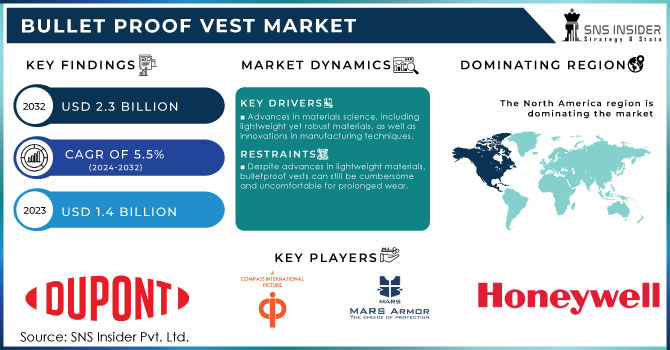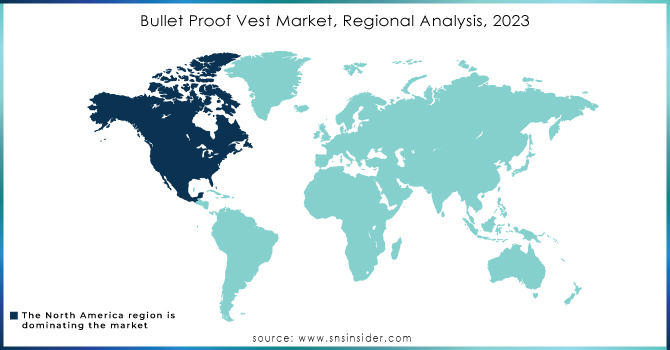Bullet Proof Vest Market Report Scope & Overview:
The Bullet Proof Vest Market was valued at USD 1.4 billion in 2023 and is expected to reach USD 2.3 billion by 2032, growing at a CAGR of 5.5% over the forecast period 2024-2032. The Bulletproof Vest Market, also known as the Body Armor Market, refers to the industry involved in the manufacturing, distribution, and sale of protective clothing designed to provide ballistic protection to individuals, primarily law enforcement officers, military personnel, security personnel, and civilians. Bulletproof vests are designed to reduce the chance of injury or death by absorbing and dispersing the impact energy from bullets and other projectiles. These vests are typically made from various materials, such as high-strength synthetic fibers (e.g., Kevlar, Dyneema), ceramic plates, and composite materials. They come in different levels of protection, ranging from soft armor (used for handguns and lower-velocity projectiles) to hard armor (used for rifles and higher-velocity projectiles). The market for bulletproof vests has seen significant advancements in materials, design, and technology over the years, leading to more lightweight and comfortable options while maintaining high levels of protection. Factors that influence the Bulletproof Vest Market include, Military and Law Enforcement Demand for bulletproof vests are primarily driven by military and law enforcement agencies seeking to protect their personnel from potential threats in the line of duty. Civic and Private Use Bulletproof vests are also used by civilians for personal protection, especially in high-risk environments or situations.

To get more information on Bullet Proof Vest Market - Request Free Sample Report
Geopolitical Factors are regional security concerns, conflict zones, and crime rates that can impact the demand for protective equipment like bulletproof vests. Technological Advancements are Innovations in materials science and manufacturing techniques that can lead to lighter, more flexible, and more effective protective gear. Regulations and Standards Government regulations and industry standards often dictate the requirements for body armor in terms of protection levels, quality, and safety. Economic Factors are the Economic stability and government budgets that can influence procurement decisions by law enforcement and military agencies. Global Events is the Events such as terrorist attacks, armed conflicts, and civil unrest that can trigger spikes in demand for protective gear. The bulletproof vest market is part of the broader defense and security industry. It's characterized by competition among manufacturers to create more advanced and effective protective solutions while considering factors like wearer comfort and mobility. The market's growth is tied to developments in materials science, ballistics research, and changing security needs worldwide. Another motivating factor in the bulletproof jacket sector is the United States government's increased defence budget spending. Additionally, rising security worries are one of the reasons why the government is increasing the defence budget in order to bolster security defences. Bulletproof jackets are designed to protect the user against the effects of weapon bullets on human organs. The jacket reduces the impact of small explosive pieces and keeps projectile bullets from piercing the wearer's body. Weaved or laminated fibres are stacked with polythene plates and metal or ceramic ballistic plates to create them.
MARKET DYNAMICS
DRIVERS:
-
Advances in materials science, including lightweight yet robust materials, as well as innovations in manufacturing techniques.
-
Law Enforcement and Military Modernization is the driver of the Bullet Proof Vest Market.
As law enforcement agencies and military forces seek to enhance the safety and effectiveness of their personnel, there is a continuous need for improved protective gear, including bulletproof vests.
RESTRAIN:
-
Despite advances in lightweight materials, bulletproof vests can still be cumbersome and uncomfortable for prolonged wear.
-
Sensitivity to Environmental Conditions is the restrain of the Bullet Proof Vest Market.
Extreme temperatures, humidity, and exposure to certain chemicals can degrade the performance and lifespan of bulletproof vest materials.
OPPORTUNITY:
-
Innovations in manufacturing, such as 3D printing and advanced textile techniques, can lead to more efficient production processes.
-
Innovative Materials are the opportunity for the Bullet Proof Vest Market.
The development of new materials with improved ballistic protection capabilities and lighter weights can revolutionize the market by offering enhanced protection and comfort.
CHALLENGES:
-
Designing bulletproof vests that provide optimal protection without compromising wearer comfort, and mobility is the challenge.
-
Multi-Threat Protection is the challenge of the Bullet Proof Vest Market.
Developing vests that offer protection against a wide range of ballistic threats, as well as potential additional threats like stabbings, remains a complex task.
IMPACT OF RUSSIA-UKRAINE WAR
According to customs and trade data obtained by POLITICO from Import Genius, a customs data aggregator, in 2022, multiple Asian companies, including one linked to the Beijing government, sent parts for body armour manufacturing to Klass, a Russian manufacturer of body armour with ties to the country's national guard and law enforcement. According to trade statistics, a Russian body armour company is importing Asian components for its vests, some of which are being utilised on the battlefield in Ukraine. So far this year, Russia has purchased more than $110 million in drones from China, which is 35 times more than Ukraine. According to Asian and Ukrainian customs statistics, Asian shipments of ceramics, a component used in body armour, climbed by 69% to Russia to more than $235 million, while falling by 61 % to Ukraine to a measly $7 million. Impact of Russian Ukraine war on Bullet Proof Vest Market share has gained profitable up to 10-12.5%
IMPACT OF ONGOING RECESSION
Asian company, whose firm sells bulletproof vests, rifle bags, and other tactical gear to the United States, originally contemplated relocating some production to Southeast Asia a few years ago, but nothing came of it. However, when trade tensions erupted into a tariff war last year, it was the final straw. The Asian manufacturer chose to start creating vests for its US clients in Myanmar instead, a day after the US put extra taxes on $220 billion of Asian imports in 2020. Since then, the United States government has increased duties on Asian imports, bringing the US tax on bulletproof vests to 43.8%. Due to high operating expenses at home, several Asian manufacturers have already begun to shift part of their capacity to countries in recent years. The trade war is now causing other companies to follow suit, particularly those producing low-tech and low-value items. The global market for bulletproof vests will increase its product prices by up to 3.4% during the current recession.
KEY MARKET SEGMENTATION
By Material
-
Ultra-High-Molecular-Weight Polyethylene
-
Kevlar
-
Graphene
By Type
-
Level II
-
Level IIA
-
Level Ill
-
Level IIIA
-
Level IV
By Product
-
Hard Armor Plate
-
Flexible Ballistic
By End User
-
Law Enforcement
-
Military
-
Civil
REGIONAL COVERAGE:
North America
-
US
-
Canada
-
Mexico
Europe
-
Eastern Europe
-
Poland
-
Romania
-
Hungary
-
Turkey
-
Rest of Eastern Europe
-
-
Western Europe
-
Germany
-
France
-
UK
-
Italy
-
Spain
-
Netherlands
-
Switzerland
-
Austria
-
Rest of Western Europe
-
Asia Pacific
-
China
-
India
-
Japan
-
South Korea
-
Vietnam
-
Singapore
-
Australia
-
Rest of Asia Pacific
Middle East & Africa
-
Middle East
-
UAE
-
Egypt
-
Saudi Arabia
-
Qatar
-
Rest of Middle East
-
-
Africa
-
Nigeria
-
South Africa
-
Rest of Africa
-
Latin America
-
Brazil
-
Argentina
-
Colombia
-
Rest of Latin America
REGIONAL ANALYSIS
North America: North America led the market with the biggest market share. This increase might be linked to the largest defence expenditure on the acquisition of modern body armour. The United States exclusively spent million on army body armour acquisition. Furthermore, prominent North American companies such as US ARMOUR CORPORATION, DuPont, Point Blank Enterprises, Inc., and others are expected to drive the bulletproof vest market.
Asia Pacific: During the predicted period, Asia-Pacific will see amazing growth. The increase is attributed to political confrontations over cross-border issues, rising terrorism in Asian nations, and increased expenditure in the acquisition of next-generation body armour. The Indian Army inked a million-dollar contract with SMPP Private Limited to purchase bulletproof jackets.

Need any customization research on Bullet Proof Vest Market - Enquiry Now
KE PLAYERS
Some major key players in Bullet Proof Vest Market are Hawk Protection, Wenzhou Start Co., KDH defence systems, U.S. Armor Corporation, BulletSafe, E.L Dupont, Compass International., MARS Armor, Armourshield, Honeywell International and other players.
RECENT DEVELOPMENT
In 2021: The Queensland Government announced plans to issue the Queensland Police Service (QPS) with integrated load-bearing vests (ILBV). The QPS will receive 12,200 new integrated load bearing vests from 2021, replacing 4,750 already in service, as well as 4,450 ballistic plates and those that are currently used.
In 2021: Researchers at MIT and the California Institute of Technology revealed the development of a nanoengineered material that outperforms current bulletproof vests comprised of Kevlar or steel. The material is composed of linked carbon "tetrakaidecahedrons" that may absorb the impact of minuscule bullets.
In 2021: The lightweight Bullet Proof Jacket (BPJ) was created by the Defence Materials and Stores Research and Development Establishment (DMSRDE) lab of the Defence Research and Development Organisation (DRDO). The bulletproof vest weighs around 9 kg and passes the Indian Army's quality criteria.
| Report Attributes | Details |
| Market Size in 2023 | US$ 1.4 Bn |
| Market Size by 2032 | US$ 2.3 Bn |
| CAGR | CAGR of 5.5 % From 2023 to 2030 |
| Base Year | 2023 |
| Forecast Period | 2024-2032 |
| Historical Data | 2020-2022 |
| Report Scope & Coverage | Market Size, Segments Analysis, Competitive Landscape, Regional Analysis, DROC & SWOT Analysis, Forecast Outlook |
| Key Segments | • By Material (Ultra-High-Molecular-Weight Polyethylene, Kevlar, Graphene) • By Type (Level II, Level IIA, Level Ill, Level IIIA, Level IV) • By Product (Hard Armor Plate, Flexible Ballistic,) • By End User (Law Enforcement, Military, Civil) |
| Regional Analysis/Coverage | North America (US, Canada, Mexico), Europe (Eastern Europe [Poland, Romania, Hungary, Turkey, Rest of Eastern Europe] Western Europe] Germany, France, UK, Italy, Spain, Netherlands, Switzerland, Austria, Rest of Western Europe]). Asia Pacific (China, India, Japan, South Korea, Vietnam, Singapore, Australia, Rest of Asia Pacific), Middle East & Africa (Middle East [UAE, Egypt, Saudi Arabia, Qatar, Rest of Middle East], Africa [Nigeria, South Africa, Rest of Africa], Latin America (Brazil, Argentina, Colombia Rest of Latin America) |
| Company Profiles | Hawk Protection, Wenzhou Start Co., KDH defence systems, U.S. Armor Corporation, BulletSafe, E.L Dupont, Compass International., MARS Armor, Armourshield, Honeywell International |
| Key Drivers | • Advances in materials science, including lightweight yet robust materials, as well as innovations in manufacturing techniques. • Law Enforcement and Military Modernization is the driver of the Bullet Proof Vest Market |
| Market Restraints | • Despite advances in lightweight materials, bulletproof vests can still be cumbersome and uncomfortable for prolonged wear. • Sensitivity to Environmental Conditions is the restrain of the Bullet Proof Vest Market. |

